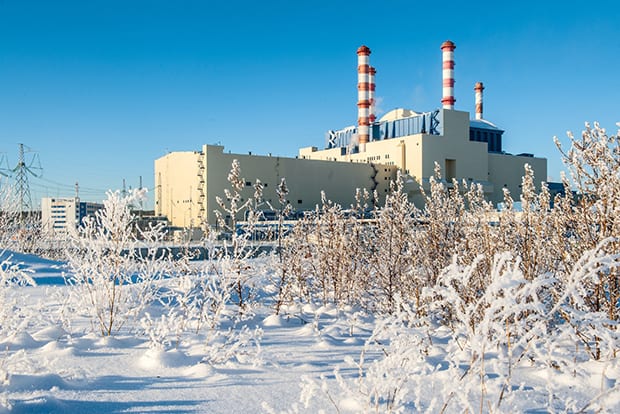MOX Nuclear Fuel Loaded in Russian Reactor, More to Come
The post MOX Nuclear Fuel Loaded in Russian Reactor, More to Come appeared first on POWER Magazine.
Power plant engineers have loaded 18 mixed-oxide (MOX) fuel assemblies in Unit 4 at the Beloyarsk nuclear power plant in Sverdlovsk Oblast, Russia.
Distinct from traditional nuclear fuel with enriched uranium, MOX fuel pellets are based on the mix of nuclear fuel cycle derivatives, such as plutonium oxide bred in commercial reactors and uranium oxide derived by defluorination of depleted uranium hexafluoride-the so-called secondary tailings of uranium enrichment facilities.
Plans for More MOX Fuel to Be LoadedBeloyarsk Unit 4 (Figure 1) is a BN-800 design, the world's most powerful fast neutron reactor. It was a POWER Top Plant in 2016. Rosenergoatom and TVEL (the power generation and nuclear fuel divisions of Rosatom State Corp., respectively) plan to load another batch of 180 MOX fuel assemblies later this year. The group has committed to replacing all remaining uranium-based fuel assemblies with MOX fuel by the end of 2021. If completed as planned, it will be the first time a Russian fast neutron reactor operates with a full load of MOX fuel.
 |
| 1. The Beloyarsk nuclear power plant. Courtesy: TVEL Fuel Co. of Rosatom |
"Rosatom strategy is aimed at the dual-component nuclear power system with both thermal neutron and fast neutron reactors, and closing nuclear fuel cycle, which would solve a number of highly important tasks. First, this would exponentially boost the feedstock for nuclear power plants. Second, this would enable to recycle spent nuclear fuel instead of storage. And third, we once again involve into nuclear fuel cycle and utilize the accumulated ground stocks of depleted uranium hexafluoride and plutonium," Vitaly Khadeev, vice president for Development of Closed Nuclear Fuel Cycle Technologies and Industrial Facilities with TVEL JSC, said in a statement announcing the accomplishment.
Serial batch production of MOX fuel started in late 2018 at the Mining and Chemical Combine site in Zheleznogorsk, Krasnoyarsk region (Russia's East Siberia). The fabrication shop is a highly automated facility, according to TVEL.
"At power unit No. 4, we have carried out the first general overhaul in four years of its operation. This power unit has two tasks, not only to produce electricity, but also to master a promising technology that is important for the future of nuclear power. The works performed during the overhaul are aimed to ensure the long-term safe operation of the whole power unit and the reliability of equipment," Ivan Sidorov, Beloyarsk's director, said in a press release.
U.S. MOX Fuel Fabrication Facility FiascoMOX fuel has been fabricated and used in Europe for many years. In the U.S., however, MOX production has faced challenges. The Department of Energy's National Nuclear Security Administration (NNSA) broke ground on a MOX Fuel Fabrication Facility (MFFF) at the Savannah River site in Aiken, South Carolina, in October 2005.
The NNSA aimed to eliminate a total of 68 metric tons of surplus weapon-grade plutonium both in the U.S. and in Russia. The plutonium disposition program was based on a nonproliferation agreement signed by the two countries in 2000. The goal was to dispose of plutonium by converting it to MOX fuel for use in existing nuclear reactors. Once the MOX fuel has been irradiated, the plutonium can no longer be readily used for nuclear weapons.
In February 2016, the MFFF construction consortium reported that about $5 billion had been spent on the project, but it still expected about $3 billion more would be needed to finish the job. Progress in July 2016 reportedly included 93% of concrete and 96% of rebar installed; 325 glove boxes on contract with 129 installed; 27 of 28 long lead glove boxes tested; 72 of 73 tanks installed; and 22 of 31 active gallery modules installed. But in October 2018, the NNSA terminated the contract, citing a study that found the total MFFF project cost would be about $17.2 billion, with operations starting as late as 2048.
The NNSA reached a comprehensive settlement agreement with the consortium in November 2019 to resolve all contract closeout matters pertaining to the MFFF project. The agreement allows the NNSA to move forward with strategic plans at a more reasonable cost to taxpayers, it said.
"Now we can fully focus on our proposal to repurpose MOX for plutonium pit production-a capability the United States needs to maintain a safe, secure, and reliable nuclear deterrent," Lisa E. Gordon-Hagerty, DOE under secretary for Nuclear Security and NNSA administrator, said in a statement announcing the settlement. "And while we move forward with plans to repurpose the MOX facility, NNSA remains committed to removing surplus plutonium from South Carolina using the proven dilute and dispose method."
-Aaron Larson is POWER's executive editor (@AaronL_Power, @POWERmagazine).
The post MOX Nuclear Fuel Loaded in Russian Reactor, More to Come appeared first on POWER Magazine.